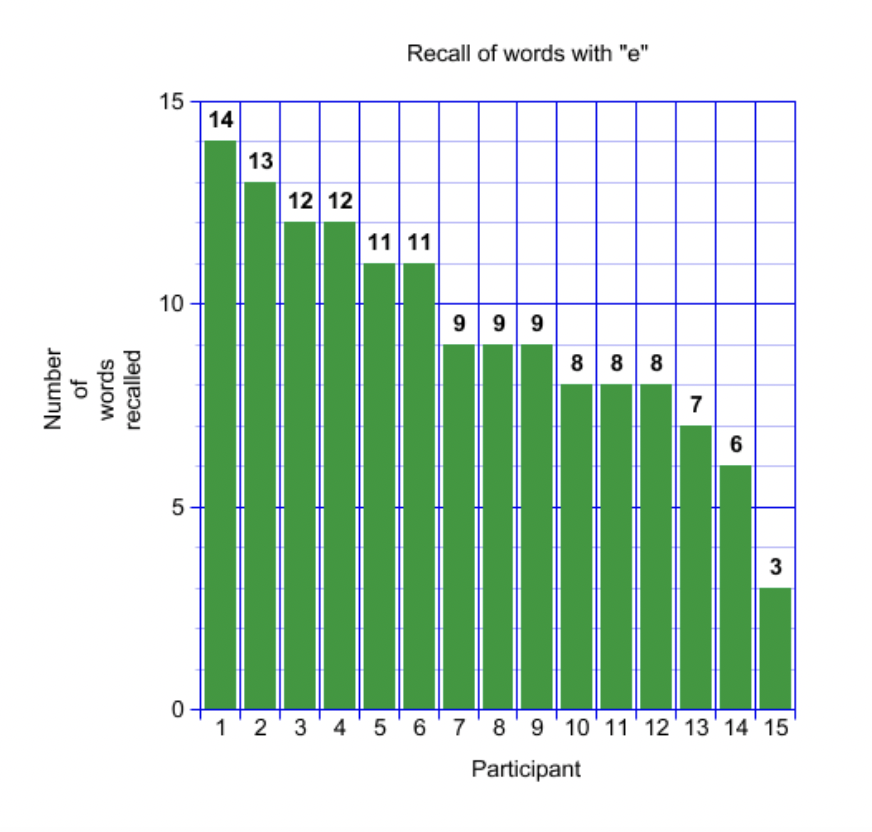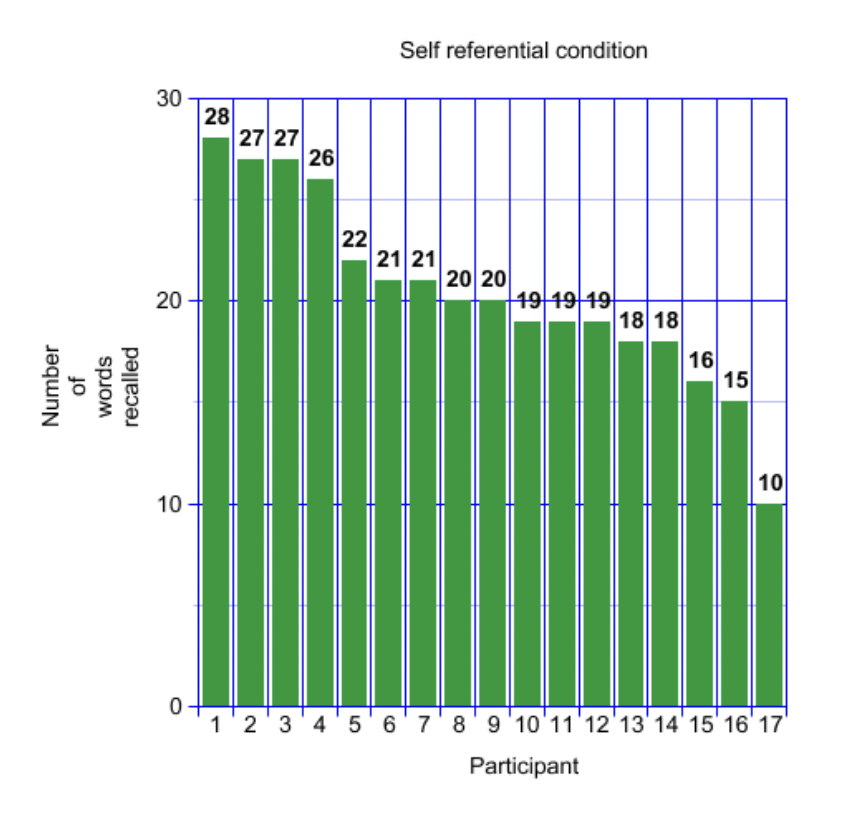IA Exemplar Low
 The sample below is one of three exemplars that I will be using with my students. They are all from the same experiment, there is a "high", a "mid" and a "low" scoring internal assessment.
The sample below is one of three exemplars that I will be using with my students. They are all from the same experiment, there is a "high", a "mid" and a "low" scoring internal assessment.
The experiment by Rogers, Kuiper and Kirker (1977), which focuses on the self-reference effect, can be found here.
The appendices do not include the letter of consent, materials, or the debriefing notes. The appendices do include the raw data and statistical calculations. Failure to include raw data or statistical calculations is penalized in the analysis.
Introduction
We decided to replicate a study by Rogers, Kuiper and Kirker (1977). In the original study, students were shown a list of words and then asked either "is there an "e" it this word?" or “Does this describe you?” After all the words were finished, asked to write down as many words as they could remember. The researchers found that those that were asked "Does this describe you?" remembered more words.
The aim of this study is to replicate this study in an international high school. The null hypothesis is that there will be no difference in the number of words remembered under the two different conditions. The research hypothesis is that there will be a significant difference between the two groups. To prove this, we used an experimental method.
Exploration
There were two groups. One group was asked whether the letter e is in the word. The other group was asked to think about whether the word describes them. Then they were read a list of words. In order to create the list of words, we first consulted websites for lists of positive and negative personality adjectives. After the list was read and they answered the questions, we asked them first to count backwards from 100 by 2's and then they were asked to recall as many words as possible. The sample was made up of two IB English classes. There were 32 participants - with approximately the same number of participants in each condition. A sample of opportunity was used, because it was easy to get a hold of. In one group, there were 8 girls and 9 boys; in the other group there were 12 girls and 3 boys. Before we began the experiment, we got their consent by getting them to sign a form (see app ii). We also promised them that we would not tell anyone their results. Finally, we did a debriefing (see app iii) in case they felt any trauma from the experiment so that we could make an arrangement with the school counselor to help them.
Analysis
Here are the results of our experiment.
Table 1. Descriptive statistics
| Condition 1 | Condition 2 | |
| Mean | 9.33 | 20.35 |
| Median | 9.0 | 20.0 |
| Mode | 9.0 | 19.0 |
| Range | 12.0 | 19.0 |
We can see that the group that was asked if there was an "e" remembered fewer words than the group that was asked if the word describes them. This shows that personalization is an important part of how we learn. The difference between the groups is 12.43 words. This is enough to say that our results are significant and that we can prove our hypothesis. The median is the middle number. It is interesting that the mode and the median are the same. There was actually more than one mode for the first condition, but since the median was also the mode, that is the most important of the numbers. The range shows the variance of the data. It is much bigger for the second condition than for the first condition. That means that the results in the second group are not as reliable as in the first group. This may mean that our results are not valid. The following graphs show how many words were remembered in each condition.


In order to see if our hypothesis was correct, a t-test was carried out. The test showed that the data was significant at p < 0.0001. This means that we can reject the null hypothesis. It appears that there is a significant difference when people are asked if there is an e in a word, and when they are asked if the word describes them. Personalizing education would probably be the best way to help children to learn.
Evaluation
Our study was successful and got the same results as Rogers, Kuiper & Kirker (1977). It seems that if we think about how a word describes us, we are more likely to remember it.
There were many limitations to our study. In our procedure we were supposed to do a distraction task to make sure that the words were actually in long-term member. But because we had two different groups of researchers carrying out the study, one group had the distraction task and one did not. This may be the reason that the second group remembered more words than the first group. In a future replication, we would make sure that both groups had the distractor task and that there was only one set of researchers doing both conditions so that there would not be any differences in the procedure.
Another limitation of the study was that we used a repeated measures design. Because there were so many words, the participants could have been bored and not cooperated. It seemed like many of the participants were stopped paying attention half way through the experiment. If we were going to do this again, we should have a shorter list of words or do it at a different time of day. Since we were doing it just before lunch, the participants could have been hungry and that may have influenced their motivation.
Another limitation is that there were many students in the sample who did not speak English as their first language. If I were going to do this again, I would give them an English test first and take any participants out of the sample who did not have an average level of English. We cannot know if they did not remember the words because they don't speak enough English, or because of the change in the independent variable.
For future research, it would be interesting to see what would happen if we asked different questions like "Do you like this word" or "Do you know where this word comes from?" This may also influence how many words they remember.
From our study we are able to conclude that thinking about the personal relevance of a word affects your ability to remember it.
Works cited
Rogers, T. B., Kuiper, N. A., & Kirker, W. S. (1977). Self-reference and the encoding of personal information. Journal of Personality and Social Psychology, 35, 677-688.
Appendix i. Raw data
| Shallow | 8 | 12 | 14 | 11 | 9 | 7 | 12 | 8 | 3 | 13 | 9 | 6 | 8 | 9 | 11 | ||
| Self-referential | 22 | 28 | 19 | 15 | 21 | 19 | 16 | 10 | 27 | 19 | 27 | 21 | 18 | 20 | 26 | 20 | 18 |
Assessment
Introduction
The study is identified and outlined, but no theory is identified or explained. The aim of the study is not appropriate and there is no explanation of why this study is relevant. The null and research hypothesis are not correctly stated and the variables are not identified or operationalized. 1 mark
Exploration
The design is not identified. The sampling technique is identified with limited explanation. Minimal characteristics of the participants are stated and not explained in terms of the experiment. No controls are identified. There is an attempt to describe the development of materials, but this is very limited. The overall structure of the exploration is not well presented. 1 mark.
Analysis
Descriptive and inferential statistics were applied; however, the calculations of the inferential statistics are not included in the appendices. The mode is not correctly explained. The range is not an appropriate measure of variance for this data set. A correct graph is not presented. A conclusion is stated but not correctly explained with regard to the data. 2 marks
Evaluation
The findings of the student's research are stated in limited detail and without reference to the background theory. The reference to the original study is superficial. Limitations are sometimes based on "human error" - that is, errors made by the candidates in carrying out the study. The approach to evaluation of the study is not rigorous. Limitations are not explained. The modification is not well explained. The ideas for further research are not relevant to the study that was replicated. 2 marks.
Total: 6 marks

 IB Docs (2) Team
IB Docs (2) Team
